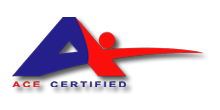 Jumping
and landing techniques are crucial to teach to younger and lesser experienced
athletes that have never done any form of plyometric or jump training.
In order to be able to correctly perform plyometrics the execution of
jumping and landing must be mastered first.
Jumping
and landing techniques are crucial to teach to younger and lesser experienced
athletes that have never done any form of plyometric or jump training.
In order to be able to correctly perform plyometrics the execution of
jumping and landing must be mastered first.
The
primary issue with landing is the inability to stabilize the legs via
the hip
musculature, and the feet via the lower leg musculature. The hip weakness
can have a major impact on the functioning of the feet and ankles as
well. The other area of concern with landing is the strength of the musculature
around the pelvis and spine. The muscles must be strong enough
to dissipate forces away from the pelvis and spine.
Without
going into too much detail the major concern is that the knees are able
to remain in line with the feet and not cave in (valgus) during
landing and
jumping. The other concern is the ability of the pelvis and spine to
avoid extreme
flexion or extension of the spine during landing.
Many
plyometric activities require the athlete to rebound off the ground quickly
using little bend of the knee and primarily force production from the lower
leg. Examples of this form of quick jumping would be jump rope, line drills,
and hop scotch type activities. But when more advanced jumping from higher
heights are being introduced the athletes must learn to push the hips back
and allow the shoulder to come forward during the landing. If the
hips do
not go back, during a jump that will require the knees to bend quite
a bit due
to the height of the jump, the knees will get pushed forward as the athlete
goes way up on the balls of the feet. This technique puts large amounts
of stress on the knee joint and soft tissues. Another potential
injury that
can occur from this knee forward approach is to the lower back. When the
knees push forward the hips will follow and the lower back will hyper-extended in many cases to maintain balance and an upright position. If this
is done aggressively there can be damage to the structure of the low back.
This
is why it is a must that all athletes learn how to jump and more importantly
how to land.
Here
are some basic plyometric and jumping/landing exercises and progressions
In-place
jump and hold
Low hurdle jump and rebound and hold
Low
hurdle continuous jumps
CLICK HERE to contact me about youth training and high performance training for adults
Get The Most Comprehensive Vertical Jump Program Available.
+++++++++++++++++++++++++++
The only program that targets every facet of vertical explosion. Effectively training every aspect of vertical jump is the only way to maximize your vertical jump explosion.
The Jump Manual is an "all in one" vertical jump training software that provides you everything you need in order to achieve your maximum vertical jump and quickness.
CLICK HERE To View The Product Site And Place An Order.
.jpg)





0 Comments:
Post a Comment